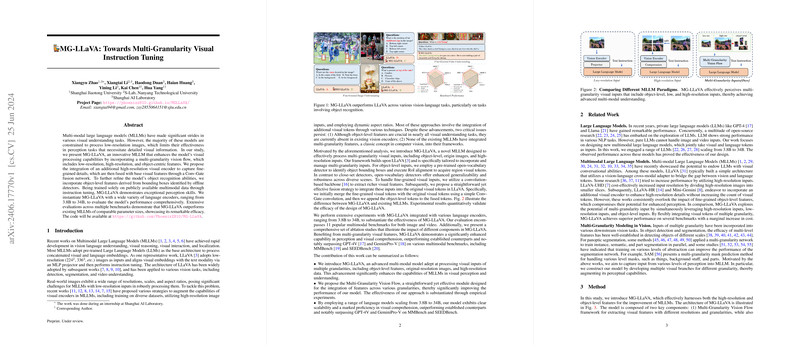An Analysis of MG-LLaVA: Multi-Granularity Visual Instruction Tuning
MG-LLaVA introduces a sophisticated framework aimed at enhancing the performance of Multi-Modal LLMs (MLLMs) in visual understanding tasks, by addressing a prevalent limitation: the ability to process only low-resolution images. This paper presents a novel approach that incorporates multi-granularity visual inputs to facilitate detailed visual analysis while integrating object-centric features to improve precision in object recognition tasks.
Technical Contribution and Methodology
The core innovation in MG-LLaVA lies in its Multi-Granularity Vision Flow module, which utilizes three distinct levels of visual input: low-resolution, high-resolution, and object-centric features. The researchers design an enhanced visual processing pipeline that includes an additional high-resolution visual encoder. This encoder captures fine-grained details which are then fused with existing low-resolution visual features using a Conv-Gate fusion network. Additionally, object-level features are obtained from bounding boxes identified by state-of-the-art open-vocabulary detectors, emphasizing the model's capability to process images that are rich in detail and complexity.
The paper proposes a comprehensive framework leveraging instruction-tuning protocols. MG-LLaVA trains on publicly available multimodal data and showcases its capabilities by integrating the system with LLMs of varying sizes (3.8B to 34B parameters), demonstrating scalability and flexibility.
Empirical Findings
The extensive empirical evaluations across multiple multimodal benchmarks demonstrate that MG-LLaVA consistently outstrips previous MLLMs of comparable size, including the state-of-the-art GPT-4V and GeminiPro-V models. Notable improvements are observed in tasks requiring intricate visual perception and object recognition, such as those evaluated in MMBench and SEEDBench benchmarks. The multi-granularity approach accounts for a notable increase in performance, suggesting the effectiveness of integrating high-resolution and object-level features within the MLLM architecture.
Implications and Future Directions
This research carries significant implications for the future of AI in multimodal interactions and visual comprehension tasks. The introduction of multi-granularity processing capabilities promises improvements in AI's ability to understand and interact with complex visual environments. Such advancements could have immediate applications in autonomous systems, enhancing their perceptual capabilities and decision-making processes based on visual inputs. Further exploration could involve refining the fusion strategies, exploring new detector architectures, or adapting the model for real-time applications which requires efficient processing of high-resolution data.
Moreover, the model's proficiency in handling a variety of visual inputs points towards improved AI in fields such as augmented reality, where seamless integration of textual and visual information is crucial.
Overall, MG-LLaVA serves as a significant advancement in the integration of visual detail processing in LLMs, paving the way for more robust AI systems that can faithfully capture and understand the richness of real-world visual data. Moving forward, continued refinement and testing could unlock even greater potentials for both theoretical advancements and practical applications in AI technology.
